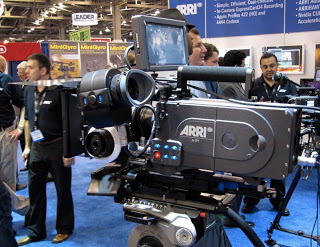The most important thing Arri have done with the Alexa is to sort out the production and post-production workflow in a manner that’s simple – probably simpler than the Red. Whether this helps them sell well and better then Red, only time will tell. The pricing is not a bit higher than the Red, though.
In it’s base configuration the Alexa shoots at a resolution of 3 k with a frame size of 3072×1728. This is downsized to HD at 1920×1080 and recorded to SxS memory cards as Apple ProRes422HQ or Apple ProRes4444. ProRes422HQ has a data rate of 145 Mbps while ProRes4444 has a data rate of 330 Mbps.
To put this into perspective, Panasonic D-5 tape stores video at 220 Mbps and Sony HDCamSR does 440 Mbps. So, in terms of data rate, and hence arguably, quality, the Alexa at ProRes4444 is somewhere between D-5 and HDCamSR.
This HD output is also available as a HD video signal which can be recorded to HD video tape like HDCam or HDCamSR. In fact, this is a safe way or working. ProRes4444 on SxS cards and the same HD video to HDCamSR tape. The tape becomes a backup.
For even higher quality and latitude, the Alexa also can record Arri RAW to a certified Arri T-link recorder. Like the Codex, S.two, or KG models of recorders. These recorders cost as much or more than the camera.
When the Alexa makes its way into India, the scenario might look like this…
The camera itself (pro set with DTE option) costs about Euros 52,500 (about Rs 40 lakhs incl. Customs Duty). And the recorder that can record Arri Raw costs another US$ 60,000 (about Rs 36 lakhs incl. Customs Duty).
The Arri Raw recorder records to hard disk about 15 Gb per min. So, if you are shooting a feature film of 120 mins at a shooting ratio of about 5:1, you need about 9000 Gb or 9 Tb space to store 10 hrs of Arri Raw rushes. At a shooting ratio of 10:1 which is what people do, when they shoot digital, you’re looking at 18 Tb. To be safe you need to back this up in two sources – disk and LTO.
Now, going by what non-film cameras like the Red rent out for in India, my guess is that the Alexa will also rent at a premium. Meaning you will need to shell out two times or more per day for an Alexa what you would, for an Arri 435 film camera. This differential alone will make potential film-makers think twice about shooting digital.
Add to that the FUD (fear, uncertainty, doubt) factor around digital, it will take a while for someone to have the guts to do an entire mainstream film on a digital camera like the Alexa. As if that isn’t enough, the sheer cost of providing safe secure storage for digital Arri Raw data, will make most producers balk at the idea.
At a conservative estimate, 8 Tb of safe secure RAID storage will cost at least Rs 1,20,000 for an 8 Tb RAID. That will add up to Rs. 2,40,000 for 16 Tb. This cost will need to be borne by the producer as well. Of course after the film is done, one can delete the unused rushes and then reuse the storage for forthcoming films. But the initial acquisition of a high quality disk storage will have to be made.
Many film-makers may settle for Apple ProRes4444 which takes up just 130 Gb per hour, or 1.3 Tb for 10 hours going up to 2.6 Tb for 20 hrs. And, for many purposes, ProRes4444 provides nearly all the bandwidth and sheer picture quality that Arri Raw would have given you, but at a fraction of the disk space and bother of file conversion.
At NAB, I was told, about 300 Alexa cameras were sold worldwide. In all probability, one or more people from india have bought one, or are considering one. So, come June, when the Alexa ships, one will see an Alexa somewhere in India, most likely in Mumbai.
For someone looking at an alternative to film, and who doesn’t want to mess with the workflow of Red because his editor or cinematographer has heard bad things about it. And needs a camera that responds just like a film camera – the Arri Alexa is a good choice. If you have the budget and inclination for shooting Raw, and a recorder is available, then go with shooting Raw.


Leave a Reply